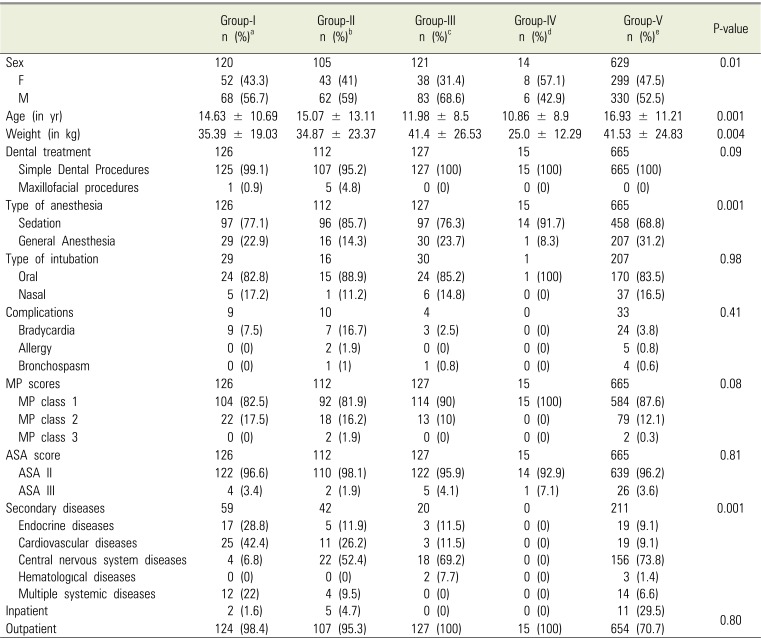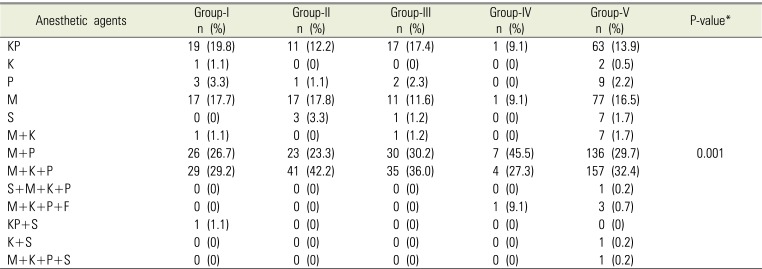1. Wang YC, Lin IH, Huang CH, Fan SZ. Dental anesthesia for patients with special needs. Acta Anaesthesiol Taiwan. 2012; 50:122–125. PMID:
23026171.

2. Lim MAWT, Borromeo GL. The use of general anesthesia to facilitate dental treatment in adult patients with special needs. J Dent Anesth Pain Med. 2017; 17:91–103. PMID:
28879336.

3. American Academy of Pediatric Dentistry. Council on Clinical Affairs. Guideline on management of dental patients with special health care needs. Pediatr Dent. 2012; 34:160–165. PMID:
23211903.
4. Erdem AP, Yaman E, Sepet E, Aytepe Z. Behavior Management and Treatment Considerations For Children With Intellectual Disability. Istanbul Üniversitesi Dis Hekimliği Fakültesi Dergisi. 2012; 46:66–73.
5. Pini DM, Fröhlich PC, Rigo L. Oral health evaluation in special needs individuals. Einstein (Sao Paulo). 2016; 14:501–507. PMID:
28076597.

6. Çağıran EY, Efeoğlu C, Balcıoğlu T, Koca H. Mental Retarde Hastalarda Dental Tedavi: Retrospektif İnceleme [Dental Treatment in Patients with Mental Retardation: Retrospective Study]. Turkiye Klinikleri J Med Sci. 2011; 31:830–836.
7. Ahuja R, Jyoti B, Shewale V, Shetty S, Subudhi SK, Kaur M. Comparative Evaluation of Pediatric Patients with Mental Retardation undergoing Dental Treatment under General Anesthesia: A Retrospective Analysis. J Contemp Dent Pract. 2016; 17:675–678. PMID:
27659087.

8. Alkan M. Our Sedation Experience on Mentally Retarded Patients. J Clin Anal Med. 2015; 6:423–427.
9. Tulgar S, Boğa İ, Can T, Bombacı E, Gezgel İ. Mental retarde ve bakım hastalarında genel anestezi altında diş çekimi: Tooth extraction under general anesthesia in mentally retarded and homecare patients: A retrospective study included different anethesia tecniques. Maltepe Med J. 2015; 7:1–5.
10. Machuca MC, Vélez A, Machuca G, Tormos HL, Nieves E, Bullón Fernández P. Dental treatment under general anesthesia offered at the Hospital Pediátrico Universitario de Puerto Rico during the years 1989–1994. P R Health Sci J. 1996; 15:289–295. PMID:
9190623.
11. Neckel W, Jacobs FE, Tolksdorf W. Oral ketamine as preferred preanesthetic medication of uncooperative patients. Anasthesiol Intensivmed Notfallmed Schmerzther. 1992; 27:381–384. PMID:
1450315.
12. Rothmaier K, Bücher K, Metz I, Pitchika V, Hickel R, Heinrich-Weltzien R, et al. Preventive and invasive treatment in special needs patients: a German retrospective study. Clin Oral Investig. 2017; 21:1343–1350.

13. Storhaug K. The mentally retarded and the dental health services. Treatment needs and preventive strategies. Nor Tannlaegeforen Tid. 1991; 101:262–265. PMID:
1834993.
14. Sari ME, Ozmen B, Koyuturk AE, Tokay U. A retrospective comparison of dental treatment under general anesthesia on children with and without mental disabilities. Niger J Clin Pract. 2014; 17:361–365. PMID:
24714018.

15. Mallineni SK, Yiu CK. Dental treatment under general anesthesia for special-needs patients: analysis of the literature. J Investig Clin Dent. 2016; 7:325–331.

16. Schnabl D, Guarda A, Guarda M, von Spreckelsen LMI, Riedmann M, Steiner R, et al. Dental treatment under general anesthesia in adults with special needs at the University Hospital of Dental Prosthetics and Restorative Dentistry of Innsbruck, Austria: a retrospective study of 12 years. Clin Oral Investig. 2019; 1–6.
17. Meitzner MC, Skurnowicz JA. Anesthetic considerations for patients with Down syndrome. AANA J. 2005; 73:103–107. PMID:
15835829.
19. Fujii-Abe K, Sasao M, Fukayama H. General anesthesia for a patient with deletion 6q syndrome in addition to laryngomalacia undergoing dental treatment. J Oral Sci. 2008; 50:493–495. PMID:
19106480.

20. Akçıl EF, Dilmen ÖK, Tunalı Y. Anaesthetic Management in Costello Syndrome. Turk J Anaesthesiol Reanim. 2015; 43:427–430. PMID:
27366541.

21. Yeoh TY, Scavonetto F, Hamlin RJ, Burkhart HM, Sprung J, Weingarten TN. Perioperative management of patients with DiGeorge syndrome undergoing cardiac surgery. J Cardiothorac Vasc Anesth. 2014; 28:983–989. PMID:
24461359.
22. Dinner M, Goldin EZ, Ward R, Levy J. Russell-Silver syndrome: anesthetic implications. Anesth Analg. 1994; 78:1197–1199. PMID:
8198286.
23. Dror Y, Freedman MH. Shwachman-diamond syndrome. Br J Haematol. 2002; 118:701–713. PMID:
12181037.

24. Kozanhan B, Saltalı AÖ. Major Özelliği Yüz – Ekstremite Defektleri Olan Sendromlar ve Anestezi Yöntem. [Syndromes with facial-extremity defects as majör feature and anesthesia management.]. Genel Tip Derg. 2016; 26:28–33.
25. Kaviani N, Ashrafi S, Jabbarifar SE, Ghaffari E. The Efficacy of Two Intravenous Sedative Drugs in Management of Uncooperative Children for Dental Treatments. J Dent (Shiraz). 2015; 16(1 Suppl):29–34. PMID:
26106632.
26. Ihara Y, Fukuda KI, Saita N, Ichinohe T. Male Gender and High Trait Anxiety Are 2 Major Factors Associated With Severe Dental Fear and Avoidance. Anesth Prog. 2018; 65:177–180. PMID:
30235434.

27. Craig DC, Boyle CA, Fleming GJ, Palmer P. A sedation technique for implant and periodontal surgery. J Clin Periodontol. 2000; 27:955–959. PMID:
11140564.

28. Bowman JP, Nedley MP, Jenkins KA, Fahncke CR. Pilot Study Comparing Nasal vs Oral Intubation for Dental Surgery by Physicians, Nurse Anesthetists, and Trainees. Anesth Prog. 2018; 65:89–93. PMID:
29952648.

29. Galeotti A, Garret Bernardin A, D'Antò V, Ferrazzano GF, Gentile T, Viarani V, et al. Inhalation conscious sedation with nitrous oxide and oxygen as alternative to general anesthesia in precooperative, fearful, and disabled pediatric dental patients: a large survey on 688 working sessions. Biomed Res Int. 2016; 2016:7289310. PMID:
27747238.

30. Özkan AS, Erdoğan MA, Şanlı M, Kaçmaz O, Durmuş M, Çolak C. Retrospective evaluation of dental treatment under general anaesthesia. Turk J Anaesthesiol Reanim. 2015; 43:332–336. PMID:
27366523.
31. Chang J, Kim HY. Prognostic factors of single-visit endodontic and restorative treatment under general anaesthesia for special needs patients. J Oral Rehabil. 2017; 44:96–104. PMID:
27862171.

32. Dziedzic A. The role of general anaesthesia in special care & paediatric dentistry; inclusion criteria and clinical indications. SAAD Dig. 2017; 33:48–54. PMID:
29616757.
33. Norderyd J, Klingberg G, Faulks D, Granlund M. Specialised dental care for children with complex disabilities focusing on child’s functioning and need for general anaesthesia. Disabil Rehabil. 2017; 39:2484–2491. PMID:
27871192.

34. Polli VA, Sordi MB, Lisboa ML, de Andrade Munhoz E, de Camargo AR. Dental Management of Special Needs Patient: A Literatüre Review. Glob J Oral Sci. 2016; 2:33–45.






 PDF
PDF ePub
ePub Citation
Citation Print
Print



 XML Download
XML Download